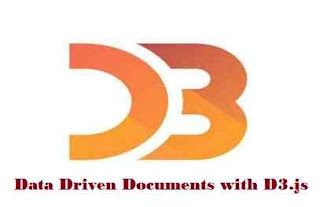What Is D3.js?
The minified version –
You can also use the standalone D3 micro libraries –
The D3 stands for “Data Driven Documents” and it was developed by Mike Bostock during hisPh.D. studies at the Stanford Visualization Group.
D3.js is a small, open-source and JavaScript library and it used to creating and manipulatingdocuments based on data. It is also control of dynamic and interactive graphicalpresentation which runs in web browsers.
D3.js is also used for manipulating HTML and SVG documents based on data. D3.js helps you bring data to life using HTML, SVG, and CSS.
Why use to D3.js?
D3.js is small and open-source and written in JavaScript.
D3.js is used for dynamic, interactive graphical presentation and data visualization frameworks.
D3.js main focuses on binding data to DOM elements.
D3.js is used for creating custom visualizations like Pie chart, graphs, bar charts or geospatial maps.
How to Installing Data Driven Documents (D3.js)?
If you are using the npm then you install - npm install d3. Otherwise, download –
The developer version –
<script src="https://d3js.org/d3.v5.js"></script>
The minified version –
<script src="https://d3js.org/d3.v5.min.js"></script>
You can also use the standalone D3 micro libraries –
<script src="https://d3js.org/d3-selection.v1.js"></script>
What Are the key features of D3.js?
1. Data Driven
2. DOM Manipulation
3. Interaction and animation
4. Custom Visualizations - Pie chart, graphs, bar charts or geospatial maps
5. Transitions
How D3.js identify on which elements to operate?
D3.js uses CSS Style selectors is used to identify the elements on which to operate. The example looks
like -
d3.selectAll("span").style("color", "red");
What about the selections in D3.js?
The D3.Js helps us to select the elements and it allows us to select one or more elements in a HTML pages. It allows us to modify, append or remove elements based on CSS selectors.
The selector methods-
1. select() – It is used to selects the HTML element based on CSS Selectors.
2. selectAll() - It is used to select multiple elements from HTML DOM.
3. append()
4. html()
5. text()
6. attr()
7. style() and
8. classed()
The Example looks like –
d3.select("body");
//OR
d3.select(".d3Test").style("color", "red");
//AND
d3.selectAll(".d3Test").attr("style", "color: red");
//OR
d3.selectAll("tr").selectAll("td").selectAll("span");
What types of sliders are available in D3.js?
In D3.js, 7 types of slider are available -
1. Default slider
2. Slider with start value
3. Slider with slide event: 0
4. Slider with default axis
5. Slider with custom axis
6. Slider with min, max and step values
7. Vertical slider
What about “Enter()” and “Exit()” selection in D3.js?
The Enter identifies any DOM elements that need to be added when the joined array is longer than the selection.
The Example looks like -
d3.select('#content').selectAll('div').data(myData).enter();
The Exit returns an exit selection which consists of the elements that need to be removed from the DOM.
The Example looks like -
d3.select('#content').selectAll('div').data(myData).exit().remove();
The Enter selection is used for create new nodes for incoming data and the Exit selection is used for eliminate outgoing nodes that is no longer required.
The Detail Example looks like –
d3.select("body")
.selectAll("p")
.data([6, 18, 14, 15, 22, 41])
.enter().append("p")
.text(function(t) { return "I’m number -" + t + "."; });
How to handle Events in D3.js?
The D3.js supports built-in events and you can also create custom events. You are also bind event listener to DOM element by using the method - d3.selection.on ().
The Example looks like -
d3.selection.on(type[, listener[, capture]]);
The List of event handling methods –
1. selection.on()
2. d3.mouse(container)
3. selection.dispatch()
4. d3.event
5. d3.touch()
For Example –
d3.selectAll("div")
.on("mouseover", function(){
d3.select(this).style("color", "red");
console.log(d3.event); //current event info
console.log(d3.mouse(this)); //x & y co-ordinates
})
.on("mouseout", function(){
d3.select(this).style("color", "steelblue")
});
How to Data Binding work in D3.js?
The D3.js is data driven and the data () function is used to join the specified array object of data to the selected DOM elements and return updated selection.
The data binding methods –
1. data() function – This function Joins the data to the selected elements
2. enter() function- This functions is used to creates a selection with placeholder references for missing elements
3. exit() function – This functions is used to removes nodes and adds them to the exit selection which can be later removed from the DOM
4. datum() function – This functions is used to injects data to the selected element without computing a join
The Example looks like –
var dataArray = ["Hello, Ths is data array!"];
var selectData = d3.select("body").selectAll("p").data(dataArray)
.text(function (dt) {
return dt;
});



0 comments:
Post a Comment